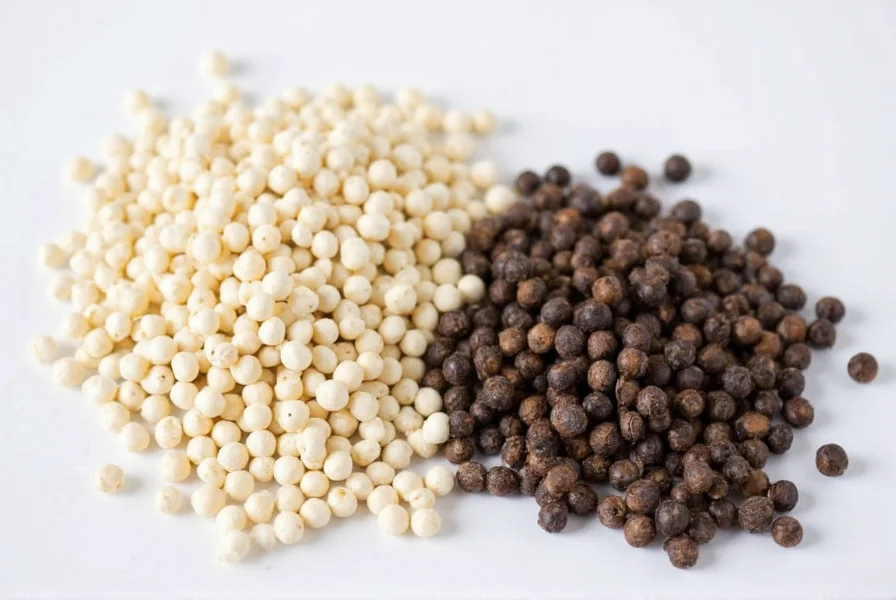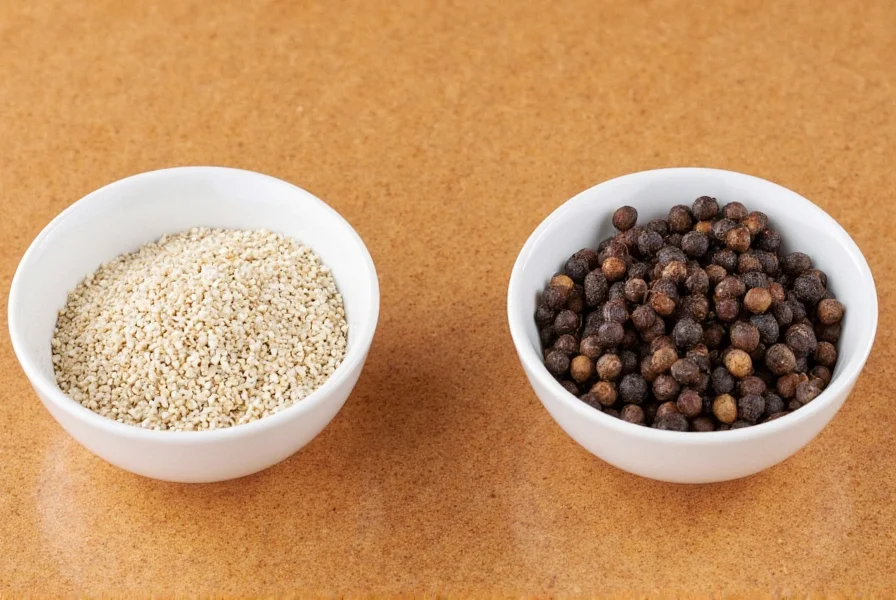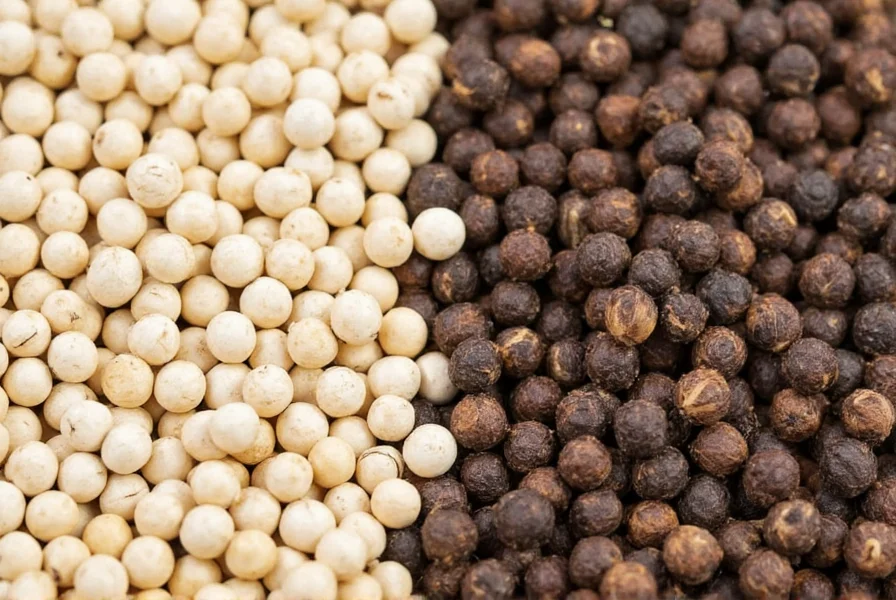Understanding the distinction between these two common spices helps elevate your cooking. While they share botanical origins, their production methods create unique characteristics that impact how they perform in various dishes.
Processing Methods: The Fundamental Difference
The primary difference between white pepper and black pepper stems from how the peppercorns are processed. Black pepper begins as green, unripe berries harvested from the Piper nigrum vine. These berries are spread out in the sun to dry, during which the outer layer (pericarp) turns black and wrinkled through enzymatic oxidation. This process preserves the fruit layer that contributes to black pepper's complex flavor profile.
White pepper, conversely, starts with fully ripe red peppercorns. After harvesting, these berries undergo a fermentation process in water for about a week, which loosens the outer fruit layer. The pericarp is then manually rubbed off, leaving only the inner seed, which is dried to produce white pepper. This removal of the fruit layer significantly alters both the flavor and appearance.
| Characteristic | Black Pepper | White Pepper |
|---|---|---|
| Source Berry | Unripe green | Ripe red |
| Processing | Sun-dried with outer layer intact | Outer layer removed before drying |
| Flavor Profile | Bold, complex, piney, floral notes | Milder, earthier, slightly fermented |
| Aroma | Sharp, pungent | Subtler, mustier |
| Culinary Use | General purpose, visible specks acceptable | Light-colored dishes, sauces, purees |
| Heat Level | Higher (more piperine in outer layer) | Slightly lower |
Flavor Comparison: Understanding Taste Differences
When comparing white pepper vs black pepper taste, the differences become immediately apparent. Black pepper delivers a more complex flavor experience with distinct top notes of pine and floral elements, followed by a sharp heat that builds gradually. This complexity makes it ideal for dishes where pepper flavor should shine through.
White pepper offers a different sensory experience—more one-dimensional with earthy, musty notes and less of the bright top notes found in black pepper. Its heat is more immediate but doesn't linger as long. Some describe white pepper as having subtle fermented notes from the processing method. This difference in flavor profile explains why certain cuisines prefer one over the other.
Culinary Applications: When to Use Each Pepper
The choice between white and black pepper often comes down to both visual and flavor considerations in cooking. Professional chefs select based on these factors:
Black pepper works best when:
- You want visible specks in the finished dish
- Preparing robust dishes like steaks, grilled meats, or hearty stews
- Creating recipes where pepper should be a noticeable flavor component
- Making spice blends where complexity is desired
White pepper shines when:
- Preparing light-colored sauces, soups, or purees where black specks would be undesirable
- Cooking traditional French or Chinese cuisine (white pepper is common in many Chinese dishes)
- Creating delicate dishes where a milder pepper flavor is preferred
- When someone has difficulty digesting the outer layer of black pepper

Nutritional and Chemical Composition
Both peppers contain piperine, the compound responsible for pepper's heat and many health benefits, but in different concentrations. Black pepper contains approximately 4-7% piperine, while white pepper has slightly less at 3-5%. This difference explains why black pepper generally delivers more heat.
The outer layer of black pepper contains additional volatile oils that contribute to its complex flavor profile but are absent in white pepper. These compounds include pinene, sabinene, and limonene, which create the distinctive aroma of freshly ground black pepper.
Common Misconceptions Clarified
Several myths persist about the difference between white and black pepper. One common misconception is that white pepper is "stronger" than black pepper—actually, black pepper typically has more heat due to higher piperine content in the outer layer.
Another myth suggests white pepper is simply bleached black pepper. In reality, proper white pepper production involves removing the outer layer through natural fermentation, not chemical bleaching. Quality white pepper should never be produced through artificial bleaching processes.

Selecting and Storing Pepper
For the best flavor experience with either type, purchase whole peppercorns and grind them fresh. Pre-ground pepper loses volatile compounds quickly, diminishing flavor. Store peppercorns in an airtight container away from light and heat.
When shopping, look for peppercorns that are uniform in size and color. High-quality black peppercorns should be dark and slightly oily to the touch, while white peppercorns should be creamy white without yellowing (which indicates age).
Conclusion: Making the Right Choice for Your Dish
Understanding the difference between white and black pepper empowers you to make better seasoning decisions. While they originate from the same plant, their processing creates distinct flavor profiles and culinary applications. Black pepper offers complexity and visual appeal in darker dishes, while white pepper provides subtle seasoning for lighter preparations without visual distraction.
Neither is inherently "better"—they're simply different tools for different culinary situations. Keeping both in your spice arsenal allows you to select the appropriate pepper based on both flavor requirements and visual considerations in your cooking.
Frequently Asked Questions
Can I substitute white pepper for black pepper in recipes?
Yes, but with flavor considerations. White pepper has a milder, earthier taste compared to black pepper's complex, bold profile. Substitute in a 1:1 ratio, but recognize the flavor will differ. White pepper works best in light-colored dishes where black specks would be undesirable, while black pepper provides more complexity in robust dishes.
Why does white pepper sometimes taste musty?
The musty flavor sometimes associated with white pepper comes from the fermentation process used to remove the outer layer. Lower quality white pepper may have stronger musty notes due to over-fermentation or poor processing. High-quality white pepper should have a clean, earthy flavor without excessive mustiness.
Which pepper has more health benefits?
Black pepper contains slightly more piperine (4-7% vs 3-5% in white pepper), the compound associated with health benefits like improved nutrient absorption. However, both provide similar nutritional profiles. The difference in health benefits between white and black pepper is minimal for typical culinary usage amounts.
Why do some restaurants use only white pepper?
Many fine dining establishments prefer white pepper in light-colored sauces, soups, and purees to maintain visual appeal without black specks. French cuisine traditionally uses white pepper for this reason, while Chinese cuisine often features white pepper for its distinctive flavor profile in certain dishes.











 浙公网安备
33010002000092号
浙公网安备
33010002000092号 浙B2-20120091-4
浙B2-20120091-4